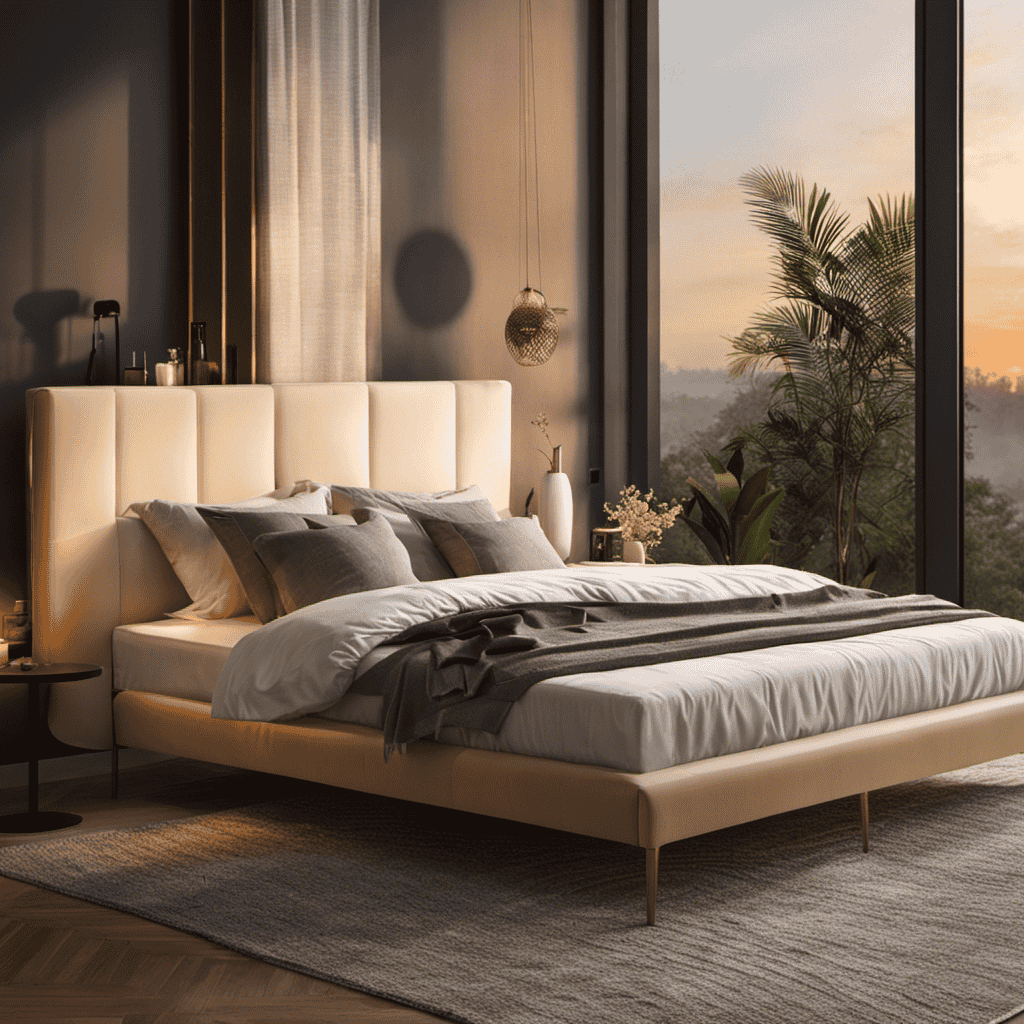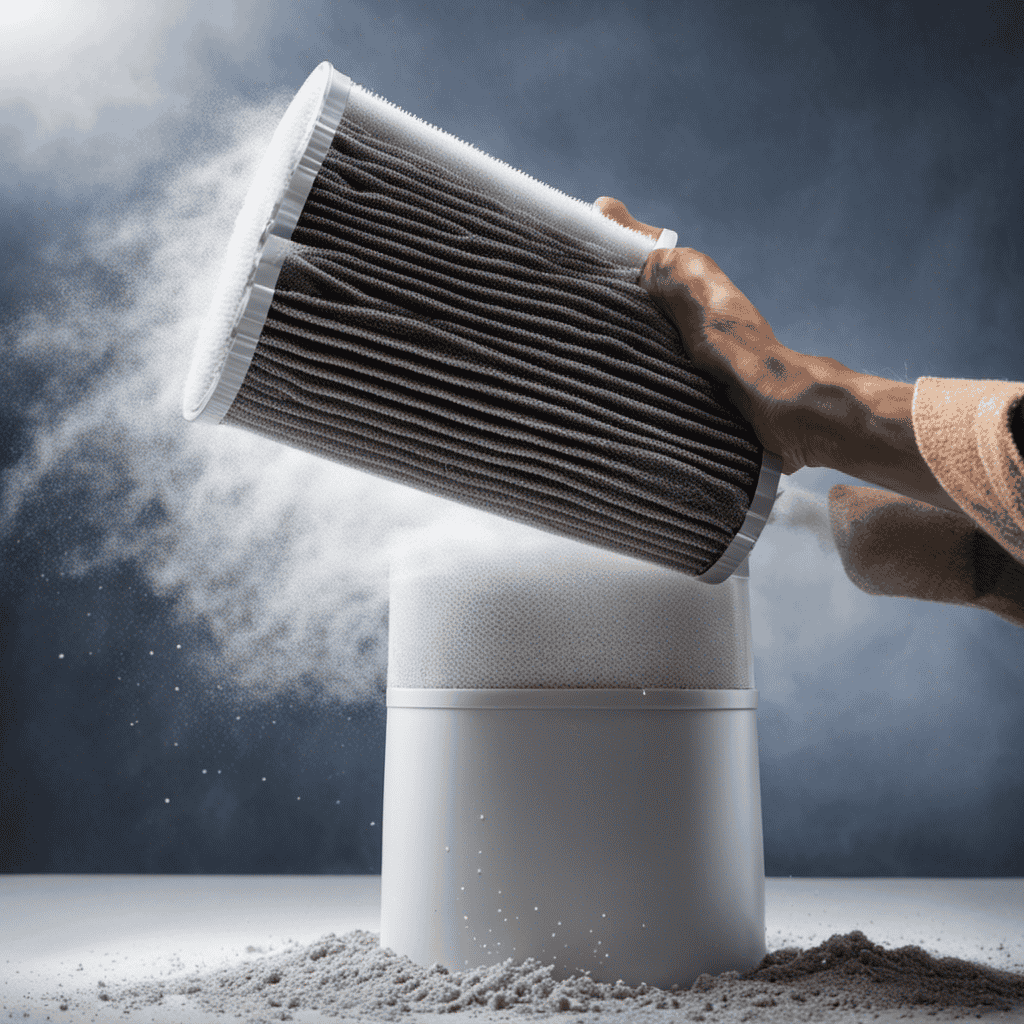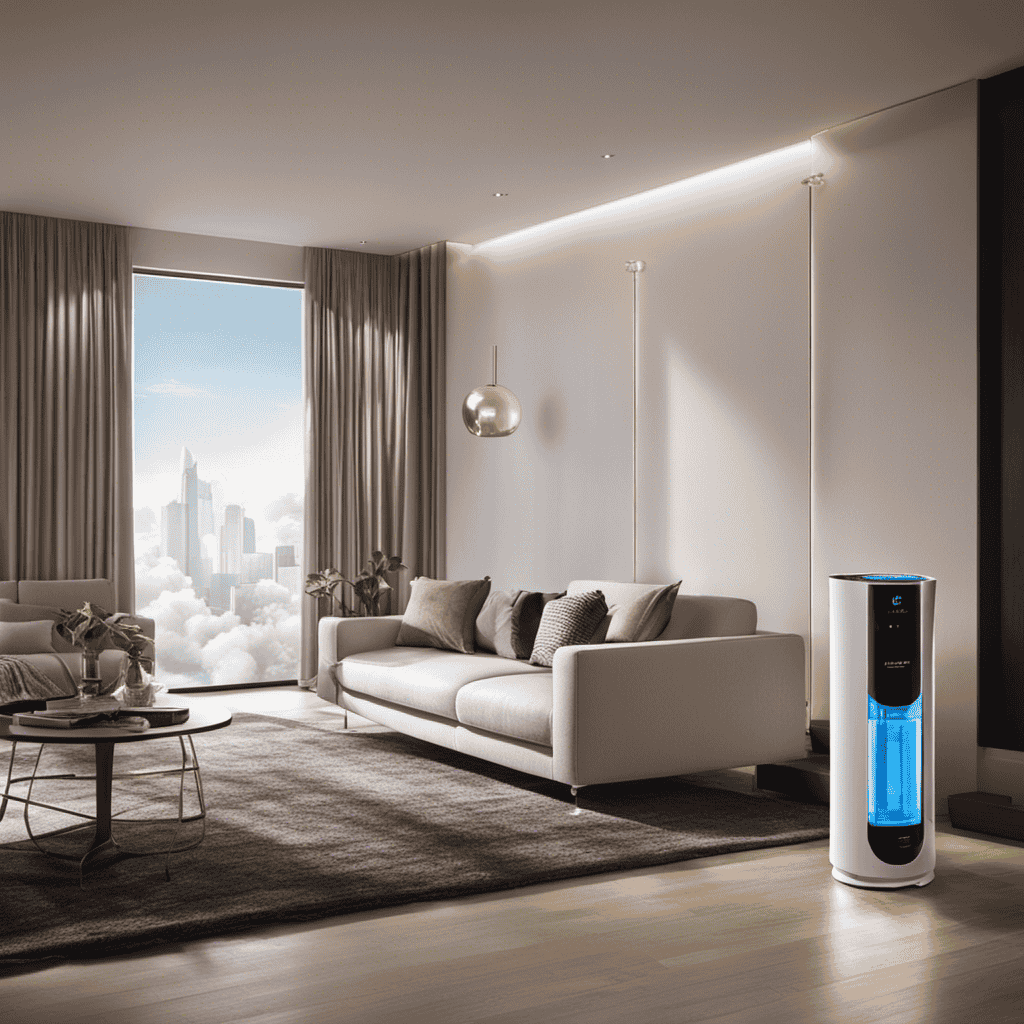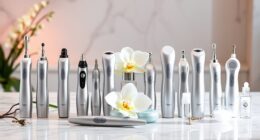As someone who is passionate about air purification, I can confidently state that discovering a quality air purifier is like a breath of fresh air. With numerous choices on the market, it is crucial to understand what distinguishes a superior air purifier from the competition.
In this article, I will delve into the key features to look for, the different air purification technologies to consider, and why clean air is vital for your home.
So, let’s clear the air and get started on our quest for the perfect air purifier.
Key Takeaways
- The key features to look for in an air purifier include the type of filter, room coverage, noise level, and cost considerations.
- Understanding air purification technologies is important, including the types of filters, purification effectiveness, noise level impact, and consideration of specific pollutants.
- There are different types of filters available, such as HEPA filters for small particles, activated carbon filters for odors and chemicals, and electrostatic filters with potential harm from ozone production.
- Regular maintenance is crucial for the long-term effectiveness of air purifiers, including cleaning or replacing filters, preventing dust buildup, and investing in a durable unit.
Key Features to Look for in an Air Purifier
When looking for an air purifier, you should consider key features such as filter type, room coverage, and noise level.
These features vary across different air purifier brands, so it’s important to do your research. The filter type is crucial as it determines the effectiveness of the purifier in removing pollutants from the air. HEPA filters are widely considered the best option, as they can capture particles as small as 0.3 microns.
Room coverage is another important factor to consider. You want to ensure that the purifier is powerful enough to clean the air in the room size you need.
Lastly, noise level is worth considering, especially if you plan to use the purifier in your bedroom or office. Some models have a quiet mode, which can be beneficial.
Cost considerations are also important, as air purifiers can range in price. It’s essential to find a balance between quality and affordability.
Understanding Air Purification Technologies
When it comes to understanding air purification technologies, there are three key points to consider: types of filters, purification effectiveness, and noise level impact.
Different types of filters, such as HEPA, activated carbon, or UV filters, offer varying levels of effectiveness in removing different types of pollutants from the air. It is important to analyze the purification effectiveness of an air purifier to ensure that it can effectively remove the specific pollutants you are concerned about.
Additionally, noise level impact should be taken into account, as some air purifiers can produce significant noise, which may be a factor to consider depending on the intended use and location of the device.
Types of Filters
You should consider the types of filters used in an air purifier before making a purchase.
The two most common types of filters are HEPA (High Efficiency Particulate Air) and activated carbon filters.
HEPA filters are highly effective at capturing small particles like dust, pollen, and pet dander. However, they are not effective at removing odors or volatile organic compounds (VOCs).
On the other hand, activated carbon filters excel at removing odors and chemicals from the air, but they are not as efficient at capturing particles.
Another type of filter is the electrostatic filter, which uses an electric charge to attract and trap particles. While electrostatic filters can be effective at capturing small particles, they can produce ozone as a byproduct, which can be harmful to our health.
Overall, each type of filter has its pros and cons, and it’s important to consider your specific needs and concerns when choosing an air purifier.
In the subsequent section, we will explore the effectiveness of these filters in purifying the air.
Purification Effectiveness
To determine the effectiveness of air purifiers, it is important to consider the types of filters used and their ability to capture particles and remove odors and chemicals. When looking for cost-effective purification options, it is essential to consider reputable air purifier brands that provide high-quality filters. To illustrate this, I have created a table comparing different air purifier brands and their filtration capabilities:
| Brand | Filter Type | Particle Capture Efficiency | Odor and Chemical Removal |
|---|---|---|---|
| Brand A | HEPA filter | 99.97% | Yes |
| Brand B | Activated carbon filter | 95% | Yes |
| Brand C | Ionizer | Varies | No |
| Brand D | UV-C light | Varies | No |
| Brand E | Ozone generator | Varies | No |
As we can see from the table, brands A and B offer the most effective purification options as they have high particle capture efficiencies and can remove odors and chemicals. On the other hand, brands C, D, and E have varying levels of effectiveness and may not be as reliable in providing clean air. Now that we have discussed the purification effectiveness, let’s move on to the next aspect of air purifiers: the impact on noise levels.
Noise Level Impact
Considering the noise levels, it’s important to choose an air purifier that operates quietly to avoid disturbances in your living space.
When it comes to air purifiers, noise level can have a significant impact, particularly on our sleep quality. A noisy air purifier can disrupt our sleep patterns, making it difficult to fall asleep or stay asleep throughout the night. Constant loud noise can also lead to increased stress levels and irritability, further affecting our overall well-being.
To prevent these issues, it’s crucial to consider the noise level of an air purifier before purchasing. Look for models that specifically mention low noise levels or have a noise decibel rating of 50 or below. Additionally, consider features like a sleep mode that operates the purifier at a lower noise level during nighttime hours.
The Importance of Clean Air in Your Home
As someone who values a healthy living environment, it’s crucial to understand the importance of clean air in your home.
Not only does clean air contribute to improved overall health, but it also helps to reduce the risk of respiratory issues and allergies.
Health Benefits of Clean Air
You’ll experience improved respiratory health when breathing in cleaner air from a good air purifier. Air purifiers have numerous benefits, especially when it comes to maintaining clean air in your home. Clean air is of utmost importance for our overall well-being and respiratory health. It helps to reduce the risk of respiratory illnesses, allergies, and asthma attacks. Here is a table that showcases the benefits of a good air purifier:
| Air Purifier Benefits | Clean Air Importance |
|---|---|
| Removes allergens and pollutants from the air | Reduces the risk of respiratory illnesses |
| Eliminates odors and unpleasant smells | Helps relieve allergies and asthma symptoms |
| Improves indoor air quality | Enhances overall well-being |
Common Indoor Air Pollutants
Common indoor air pollutants can negatively affect our respiratory health and overall well-being. Airborne allergens, such as pollen, dust mites, pet dander, and mold spores, can trigger allergies and asthma symptoms. These pollutants can irritate the respiratory system, leading to coughing, wheezing, shortness of breath, and other respiratory problems. Long-term exposure to these pollutants can even contribute to the development of respiratory diseases and worsen existing conditions.
It is crucial to address these pollutants to improve indoor air quality and safeguard our health. This is where air purifiers come into play. By effectively capturing and removing airborne allergens, air purifiers can significantly reduce their impact on respiratory health.
But how do we determine the effectiveness of an air purifier? Let’s explore this in the next section.
Air Purifier Effectiveness
Air purifiers can significantly reduce the impact of airborne allergens on respiratory health by effectively capturing and removing them from indoor spaces.
However, to ensure their long-term effectiveness, regular maintenance is crucial. Cleaning or replacing filters is an important part of air purifier maintenance. Filters can become clogged with particles over time, reducing their efficiency and potentially allowing allergens to escape back into the air.
Additionally, it is essential to clean the exterior of the unit to prevent dust buildup and maintain optimal airflow.
Another factor to consider is the durability of the air purifier. Investing in a high-quality, well-built unit can ensure its longevity and effectiveness. Look for air purifiers made from durable materials and backed by reliable warranties.
Proper maintenance and durability are key to ensuring that your air purifier continues to effectively capture and remove allergens, providing clean and healthy indoor air.
Factors to Consider When Choosing an Air Purifier
When choosing an air purifier, it’s important to consider factors such as the size of the room and the type of pollutants you want to remove. These factors will help you determine the appropriate size and filtration technology needed for optimal air purification. Additionally, it’s crucial to research and compare different air purifier brands to find the one that suits your needs and budget. To make this process easier, I have compiled a table showcasing some popular air purifier brands and their cost considerations:
| Brand | Cost Range |
|---|---|
| Brand A | $100-$200 |
| Brand B | $200-$300 |
| Brand C | $300-$400 |
| Brand D | $400-$500 |
How to Determine the Air Purifier’s Effectiveness
To assess the effectiveness of an air purifier, you can look for customer reviews and ratings online. These reviews can provide valuable insights into the performance of different air purifier models.
Look for reviews that specifically mention the air purifier’s ability to remove pollutants, such as dust, pollen, and pet dander, from the air. Pay attention to how well the purifier works in different room sizes and whether it has multiple fan speeds for customizable performance.
Additionally, consider the noise level and energy efficiency of the purifier. By taking into account these factors, you can make an informed decision about the effectiveness of an air purifier before purchasing it.
This knowledge will be useful when it comes to the subsequent section about tips for proper maintenance of your air purifier.
Tips for Proper Maintenance of Your Air Purifier
Now that we have discussed how to determine the effectiveness of an air purifier, let’s shift our focus to the importance of proper maintenance for these devices.
Regular maintenance is crucial to ensure that your air purifier continues to perform at its best and effectively clean the air in your home. Here are some tips for maintaining your air purifier:
-
Clean or replace filters: Dirty filters can hinder the air purifier’s performance. Regularly clean or replace them as recommended by the manufacturer.
-
Check for airflow obstructions: Ensure that the intake and outlet vents are not blocked by dust or debris.
-
Troubleshoot issues: If you encounter any issues with your air purifier, refer to the user manual or contact customer support for troubleshooting tips.
Common Mistakes to Avoid When Using an Air Purifier
Don’t forget to regularly clean or replace the filters in order to maintain the effectiveness of your air purifier. Proper maintenance is crucial for ensuring that your air purifier functions optimally and provides you with clean, fresh air.
However, there are also some common mistakes that people make when using an air purifier. To help you avoid these pitfalls, here are three important things to keep in mind:
-
Placement: It’s important to place your air purifier in the right location for maximum efficiency. Avoid placing it near walls or furniture that could obstruct airflow. Instead, position it in the center of the room, away from any obstructions.
-
Size: Choosing the right size of air purifier for your room is essential. A unit that is too small won’t effectively clean the air, while one that is too large may consume unnecessary energy. Consider the square footage of your room when selecting an air purifier.
-
Troubleshooting: If you encounter any issues with your air purifier, it’s important to troubleshoot them before assuming that the unit is faulty. Check the power source, clean the filters, and ensure that there are no obstructions blocking the airflow.
Frequently Asked Questions
Can an Air Purifier Remove All Types of Pollutants From the Air?
An air purifier can effectively remove many types of pollutants from the air, but not all. Regular maintenance, such as changing filters, is necessary to ensure optimal performance and keep the air clean.
Is It Safe to Use an Air Purifier in a Room Where Someone Is Smoking?
Yes, it’s safe to use an air purifier in a room where someone is smoking. It can help reduce the odor and remove some of the harmful chemicals from the air. Regular maintenance is important for optimal effectiveness.
How Long Does It Take for an Air Purifier to Clean the Air in a Room?
It depends on the air purifier’s efficiency and the factors affecting its performance. Factors like room size, airflow, and the level of pollutants can impact how long it takes to clean the air in a room.
Can an Air Purifier Remove Odors From the Air?
Yes, an air purifier can remove odors from the air. I have personally used the Dyson Pure Cool air purifier and it effectively eliminated unpleasant smells, making the air fresher and cleaner. Dyson is one of the best air purifier brands known for their quality and effectiveness.
Do Air Purifiers Consume a Lot of Electricity?
Air purifiers vary in energy consumption and electricity usage. Some models are designed to be energy-efficient, while others may consume more power. It’s essential to consider these factors when choosing an air purifier.
Conclusion
In conclusion, finding the right air purifier can make a world of difference in the quality of air we breathe.
With so many options available, it’s important to carefully consider the key features and technologies that suit our needs.
Maintaining our air purifiers properly and avoiding common mistakes ensures their effectiveness in providing clean air.
Remember, clean air is not just a luxury but a necessity for our health and well-being.
So, don’t delay, start breathing fresh air today!










